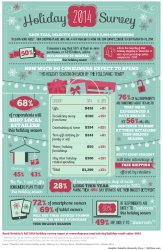Despite potential seasonal barriers to store trips such as long lines, heavy traffic and limited merchandise selection, surveyed consumers anticipate spending the majority of their holiday budget in the "brick-and-mortar" store this year, according to Deloitte's 29th annual holiday survey. Furthermore, a strong digital presence may lead shoppers from the virtual storefront to the physical storefront and convert browsers into buyers.
Among the findings:
- More than half of respondents (55 percent) are shopping at malls this holiday season, but nearly three in 10 (28 percent) will visit malls less this year. Among those shopping less at malls, the top three reasons are crowds (49 percent), better prices elsewhere (42 percent) and avoiding traffic (36 percent).
- The top three detriments cited to shopping in a physical store were long lines (40 percent), too much traffic (26 percent), and it doesn't carry the merchandise they want (25 percent).
- Consumers shopping in the store tend to be more loyal than those shopping online: Roughly half of consumers (51 percent) indicate that if a product is not available in-store, they will still try to buy from the same retailer, either from another location or its website.
- Whether shopping online or in the store, consumers plan to take advantage of several retailer offerings this year, including free shipping (68 percent), free returns (52 percent), price matching (45 percent), extended holiday hours (35 percent), order online for pick up in-store (34 percent), and free layaway (16 percent).
- Respondents with annual incomes of less than $100,000 expect to spend 54 percent of their total holiday budgets in-store, versus 46 percent for those with incomes over $100,000.
When asked which store-return policies they found most desirable, respondents favored flexible options such as the ability to return items to any store, regardless of purchase location (25 percent), refund options other than store credit (23 percent), and no receipt required (18 percent). Also at 18 percent, and perhaps the boldest indication of their desire for convenience this holiday season, respondents indicated wanting the ability to return items in January that were purchased in October through December.
While shopping in-store, nearly six in 10 (58 percent) respondents believe they are better connected with consumer information than store associates, but informed associates still top consumers' wish list when in the store. Roughly half (48 percent) indicated, "During the holiday season, I am more likely to complete an in-store purchase from a retailer that offers knowledgeable store associates."
Store associates and in-store technologies can make registers jingle
- More than six in 10 (61 percent) of consumers expect store associates will, "Help me check out quickly" and "Be knowledgeable about products." Shoppers also expect associates to let them know about discounts/offers (54 percent), greet them promptly with a welcoming attitude (42 percent), be able to match other retailers' prices (35 percent), and help them find gifts (26 percent).
- More shoppers (63 percent) plan to use in-store, self-help technology, up five percentage points from 2013. Among the 63 percent, 59 percent will use "price checkers" and 56 percent will use "self-checkout" kiosks.
Consumers are making a holiday shopping list and clicking it twice
- Among the 72 percent who will use smartphones for holiday shopping, 58 percent will use the device for finding store locations and 52 percent will use it to check prices.
- Smartphone ownership has risen to more than two-thirds (67 percent) from just half of respondents in 2012, and smartphone owners are planning to spend roughly one-quarter (27 percent) more on gifts than those who do not own smartphones.
- Nearly seven in 10 (69 percent) of tablet owners plan to use their tablets for holiday shopping. Among them nearly two-thirds (65 percent) plan to shop/browse online, while 57 percent expect to actually make purchases on these devices. Fifty percent of respondents indicated they owned a tablet, up from 38 percent in 2013.
- Deloitte forecasts that digital interactions will influence 50 percent, or $345 billioni, of retail store sales this holiday season. This figure reflects the extent to which consumers' use of desktop and laptop computers, tablets and smartphones influence brick-and-mortar store sales.
- Seventy-two percent of all respondents use social media sites such as blogs, discussion groups or social networks.
- Nearly half of respondents (45 percent) are using social media to assist in holiday shopping. Among those using social media, reasons cited included: to get gift ideas (47 percent); find discounts, coupons and sale information (45 percent); read reviews, "likes," or recommendations for products/stores (41 percent); browse products (40 percent); check with family/friends on gifts they want (32 percent); and post comments or share links about stores, sales or products (21 percent).
According to Alison Paul, vice chairman and retail sector leader, Deloitte LLP, "In-store shopping continues to be an important part of the traditional holiday shopping experience for many consumers. This holiday season, respondents indicated they will spend 52 percent of their holiday budgets in brick-and-mortar stores and only 40 percent online. Furthermore, respondents expect to spend on average 35 percent of their holiday budgets in local retail stores. For retailers, gaining a competitive edge depends on pulling multiple levers to encourage consumers to shop at one store over another. A satisfying in-store experience, an intuitive website, the right in-store innovations, informed store associates, the ability to influence purchases through mobile — all of these elements and more help distinguish successful retailers from the others."
An infographic and complete survey results are also available for download.
Source: Deloitte










